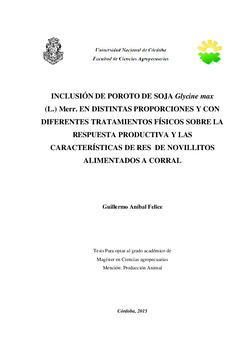| dc.contributor.advisor | Pordomingo, Aníbal J. | |
| dc.contributor.author | Felice, Guillermo Aníbal | |
| dc.date.accessioned | 2016-04-04T15:57:19Z | |
| dc.date.available | 2016-04-04T15:57:19Z | |
| dc.date.issued | 2015 | |
| dc.identifier.uri | http://hdl.handle.net/11086/2540 | |
| dc.description | Tesis (Magister en Ciencias Agropecuarias. Mención: Producción Animal)--UNC- Facultad de Ciencias Agropecuarias, 2015 | es |
| dc.description.abstract | Se realizaron dos experiencias con el objetivo de determinar los efectos del tratamiento físico (temperatura y/o molienda) y del nivel de inclusión (0, 8, 16 y 24 %) del poroto de soja sobre la respuesta animal y res en novillitos alimentados a corral. Para la primera se utilizaron 96 novillitos Angus (210 ± 14,50 Kg) los cuales fueron distribuidos de a 4 animales por corral en función de sus pesos iniciales. Para las variables aumento de peso vivo, consumo de materia seca, consumo de materia seca en relación al peso vivo e índice de conversión alimenticia. Se aplicó un diseño de factores fijos, utilizando a los corrales como unidades experimentales, en un arreglo factorial de tratamientos 2 x 4, con medidas repetidas en el tiempo. Las medias para los factores nivel de soja en la dieta se separaron con contrastes ortogonales y para los factores presentación física de la soja (entera o molida), por significancia de F. Las dietas estuvieron compuestas en los dos experimentos por grano de maíz, harina de girasol, urea, heno de pastura y núcleo vitamínico mineral, con el agregado de los diferentes niveles de soja (0, 8, 16 y 24 %) y sus tratamientos correspondientes. En la segunda experiencia se utilizaron 96 novillitos Angus (280 ± 18,50 Kg.) los cuales fueron distribuidos de a 3 animales por corral en función de sus pesos iniciales. El diseño experimental aplicado fue el mismo que el utilizado en la experiencia 1, para la presentación de la soja (cruda o desactivada). En el experimento 1 se detectaron efectos significativos para las variables APV (P = 0,001), CMS (P = 0,026) y CMSPV (P = 0,018) con la inclusión de soja cruda, tanto entera como molida, en un nivel de 24%, afectando negativamente la respuesta productiva del animal debido a la presencia de factores antitripsínicos. Niveles de hasta el 16 % de soja cruda, entera o molida, es la forma más segura de inclusión en la dieta. En el experimento 2 no se observaron diferencias significativas (P>0,05) con niveles de 24 % de inclusión con soja desactivada por tratamiento térmico, no viéndose afectada la respuesta productiva y las características de res del animal. | es |
| dc.description.abstract | Two experiments were conducted in order to determine the effects of physical treatment (temperature and / or milling) and level of inclusion (0, 8, 16 and 24 %) of soybean on animal response of pen fed steers. In the first experiment 96 Angus steers (210 ± 14,50 kg.) were distributed 4 animals per pen according to their initial weights. Pens were the experimental units allocated in a CR block design (blocked by weight). For variables live weight gain (LWG), dry matter intake (DMI) and dry matter intake in relation to body weight (DMIBW) and feed efficiency (FE), fixed factors design was applied , using the pen as the experimental unit, to which a factorial arrangement of treatments 2 x 4 , with repeated measures in time. The means for soybean factors level were separated by orthogonal contrasts. In the case of soybean physical presentation (whole or ground) means were separated by F significance. The diets in both experiments were composed by corn grain, sunflower meal, urea, hay pasture and mineral-vitamin premix, with the addition of different levels of soybean (0, 8, 16 and 24 %) with their corresponding presentation treatments. In the second experiment carcass traits were also analyzed. A group of 96 Angus steers (280 ± 18,50 kg) were distributed into 3 animal per pen according to their initial weights. The experimental design applied was the same as experiment 1 changing the significance of F for the factor temperature treatment of soybeans (raw or heat-treated). In Experiment 1, there were significant effects for LWG (P = 0,001), DMI (P = 0,026), DMIBW (P = 0,018) variables, with inclusion level of 24 %, raw soybeans either whole or ground, negatively affecting the productive response of the animal due to the presence of antitripsyn factor. Levels of up to 16 % either whole or ground are safe to include raw soybeans in the diet. In Experiment 2, no significant differences (P > 0,05) among any level of desactivated soybeans did not affect the animal growth performance and carcass characteristics. | en |
| dc.format.extent | 50 h. : tablas | |
| dc.language.iso | spa | es |
| dc.rights | Atribución-NoComercial-SinDerivadas 2.5 Argentina | * |
| dc.rights.uri | http://creativecommons.org/licenses/by-nc-nd/2.5/ar/ | * |
| dc.subject | Soja | es |
| dc.subject | Procesamiento | es |
| dc.subject | Molienda | es |
| dc.subject | Tratamiento térmico | es |
| dc.subject | Alimentación de los animales | es |
| dc.subject | Dieta | es |
| dc.subject | Engorde a corral | es |
| dc.subject | Feedlot | es |
| dc.subject | Producción animal | es |
| dc.title | Inclusión de poroto de soja Glycine Max (L.) Merr. en distintas proporciones y con diferentes tratamientos físicos sobre la respuesta productiva y las características de res de novillitos alimentados a corral | es |
| dc.type | masterThesis | es |





